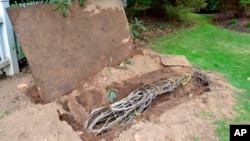Fig trees are native to Europe around the Mediterranean Sea, Asia and Africa, but they can grow in much cooler climates.
Once mature, fig trees can accept temperatures even a few degrees below freezing. Some kinds of fig trees do better in such environments than others.
Associated Press gardening expert Jessica Damiano recently wrote about caring for fig trees. She said all kinds of the trees could use protection.
Depending on the weather and pruning, a fig can grow into a shrub or a tree. Shrubs with several stems growing from the ground do best if covered for the winter. Trees with a single stem, or trunk, can be either covered or buried.
Either way, wait until the trees have dropped most of their leaves.
One popular method for burying trees for their protection is called “the Minnesota tip.”
It involves digging a narrow, shallow area where the tree can be laid. The space should be about 30 centimeters deep, 60 centimeters wide and as long as the tree is tall.
To prepare the tree, gather its branches and tie them together with soft rope.
Next, push a shovel into the soil about a half-meter from the trunk on the side opposite the hole. Lift that side of the tree’s root ball out of the ground.
Then, gently push the tree toward the hole.
When it is lying flat, cover the tree with plastic.
Pack soil around the exposed side of the roots, and around the length of the tree. Load soil over the tree. Make it at least 30 centimeters deep. You will need more soil than you removed from digging.
If you are covering, or wrapping, the tree instead, you will need cardboard, a pail, and a roll each of burlap, heavy brown paper and tar paper.
If the tree is under three years old, cut it back by one-third its size. Then, pull the branches inward and tie them together with soft but strong rope.
Working upwards from the bottom, put burlap around the tree. Then put heavy brown paper around the burlap and tie it into place.
Remove some soil from around the base of the tree. Place a large piece of cardboard into the space and bend it around the bottom half of the tree. Tie the cardboard into place.
Next, wrap tar paper around the tree. Position it outward from top to bottom. This will direct rain away from the tree.
Place soil around the tree’s base, creating a little hill. Place a pail upside-down over the top of the tree to keep the rain off.
Unwrap the tree on a cloudy day in early spring, soon after the last frost.
I’m Mario Ritter Jr.
The Associated Press reported this story. Caty Weaver adapted it for VOA Learning English.
_________________________________________________________________
Words in This Story
mature –adj. fully developed, fully grown
prune –v. to cut some parts of a tree or bush so that it will grow or look better
shrub –n. a plant that has stems of wood but is smaller than a tree
stem –n. a thin, long part of a plant that rises above the soil and supports the leaves and flowers
shovel –n. a tool used for digging the soil
pail –n. a round container that is open at the top and usually has a handle
exposed –adj. something that is not covered or protected
burlap –n. a rough, strong cloth used for making bags
tar –n. a thick, black substance that melts easily but hardens when it is cool
_________________________________________________________________
We want to hear from you.
We have a new comment system. Here is how it works:
- Write your comment in the box.
- Under the box, you can see four images for social media accounts. They are for Disqus, Facebook, Twitter and Google.
- Click on one image and a box appears. Enter the login for your social media account. Or you may create one on the Disqus system. It is the blue circle with “D” on it. It is free.
Each time you return to comment on the Learning English site, you can use your account and see your comments and replies to them. Our comment policy is here.











Forum